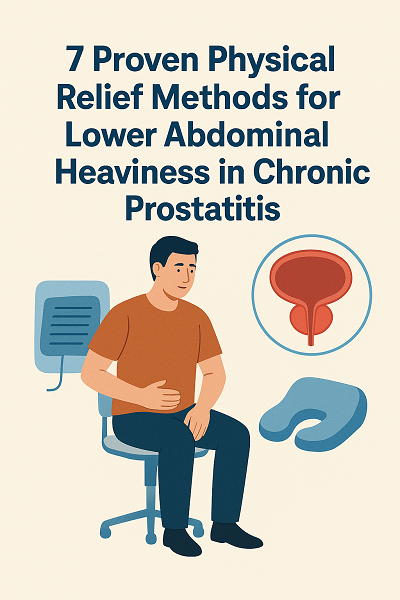7 Proven Physical Relief Methods for Lower Abdominal Heaviness in Chronic Prostatitis
updateDate:2025-09-01
click:0
createDate:2025-09-01
If you're among the millions of men experiencing prostatitis, you know that familiar sinking feeling all too well. After hours of sitting at your desk, the lower abdomen feels heavy, pressured, and uncomfortable – like carrying an invisible weight that refuses to lift. This persistent symptom affects up to 10% of men at some point in their lives, yet effective relief strategies remain surprisingly underexplored. (1)

Understanding the Sitting-Pain Connection
When you sit for extended periods, several physiological changes occur that directly impact prostatitis symptoms. The pelvic floor muscles – a hammock-like group of muscles supporting your bladder, bowel, and prostate – become compressed and tightened. Prolonged sitting reduces blood circulation to the pelvic region by up to 50%, creating a perfect storm for inflammation and discomfort.
The prostate gland, roughly the size of a walnut, sits directly below the bladder and surrounds the urethra. In chronic prostatitis, this gland becomes inflamed and swollen, making it particularly sensitive to the pressure changes that occur during prolonged sitting. The result? That characteristic heavy, dragging sensation in your lower abdomen that can persist for hours after standing up.
7 Immediate Physical Relief Strategies
1. The 20-20-20 Movement Protocol
Every 20 minutes, stand up and walk for at least 20 steps, then perform 20 seconds of gentle pelvic tilts. This simple routine, validated by urological studies, helps restore blood flow and reduces pelvic floor muscle tension. Set a phone reminder – consistency is more important than intensity.
2. Targeted Heat Therapy Application
Apply a heating pad set to medium temperature (not hot) to your lower abdomen and perineum area for 15-20 minutes. The heat increases blood circulation by up to 25% and helps relax tight pelvic muscles. For office use, consider a portable heat wrap that can be worn discreetly under clothing.
3. Strategic Seating Modifications
Invest in a donut cushion or specialized prostate cushion that reduces direct pressure on the perineum. These cushions feature a cut-out section that eliminates contact with the sensitive area between your scrotum and anus. Studies show this simple modification can reduce sitting-related pain by 40-60%.
4. Deep Diaphragmatic Breathing Technique
Practice the "4-7-8" breathing pattern: inhale for 4 counts, hold for 7, exhale for 8. This activates the parasympathetic nervous system, which directly influences pelvic floor muscle relaxation. The vagus nerve connection means that controlled breathing can provide relief within minutes.
5. Gentle Pelvic Floor Stretches
Perform the "happy baby" yoga pose: lying on your back, bring your knees toward your chest and grab the outside edges of your feet. Hold for 30-60 seconds. This stretch specifically targets the pelvic floor muscles and can provide immediate relief from heaviness and pressure.
6. Hydrotherapy Contrast Method
Alternate between sitting in warm water (98-102°F) for 3 minutes and cool water (70-75°F) for 1 minute. Repeat this cycle 3-4 times. This contrast therapy, originally developed for athletic recovery, helps reduce inflammation and improve circulation in the pelvic region.
7. Progressive Muscle Relaxation for the Pelvis
Starting with your toes, systematically tense and release each muscle group, working your way up to your pelvic floor muscles. Hold each contraction for 5 seconds, then release for 10 seconds. This technique helps identify and release unconscious muscle tension that contributes to abdominal heaviness.
Creating Your Personal Relief Routine
The key to managing chronic prostatitis symptoms lies in combining multiple approaches rather than relying on a single method. Start by implementing the 20-20-20 protocol during your workday, then add heat therapy during your evening routine. Gradually incorporate the breathing exercises and stretches as they become habitual.
Track your symptoms using a simple 1-10 pain scale before and after each technique. This data will help you identify which methods provide the most relief for your specific situation. Remember, what works best can vary significantly between individuals, so patience with the process is essential.
Complementary Treatment Approaches
While these physical relief methods provide significant symptom improvement, they often work best when combined with targeted therapeutic interventions. Traditional Chinese medicine has shown promising results in treating chronic prostatitis, with formulations like Diuretic and Anti-inflammatory Pill demonstrating effectiveness in reducing inflammation and alleviating symptoms associated with chronic prostatitis. This herbal approach focuses on clearing heat, promoting diuresis, and reducing inflammation in the urogenital system.
When to Seek Professional Help
If your symptoms worsen, include fever, or are accompanied by urinary retention, consult a urologist immediately. Chronic prostatitis often requires a multidisciplinary approach including physical therapy, medication, and lifestyle modifications for optimal management.
Frequently Asked Questions
Q: How long does it take to feel relief from these physical methods?
A: Most men experience some immediate relief within 15-30 minutes of applying heat therapy or performing the breathing exercises. However, consistent improvement typically requires 2-4 weeks of regular practice with the complete routine.
Q: Can I perform these exercises at work without drawing attention?
A: Yes, several methods are office-friendly. The 4-7-8 breathing technique, strategic seating with a cushion, and the 20-20-20 movement protocol can all be performed discreetly in most workplace environments.
Q: Are there any risks associated with these physical relief methods?
A: These techniques are generally safe for most men. However, avoid excessive heat (above 102°F) and stop any exercise that causes sharp pain. Men with heart conditions should consult their doctor before starting contrast hydrotherapy.
Q: How do I know if my chronic prostatitis symptoms require medical intervention?
A: Seek immediate medical attention if you experience fever, inability to urinate, severe pain, or blood in urine. Additionally, if physical relief methods provide no improvement after 4-6 weeks of consistent practice, consult a healthcare provider.
Q: Can dietary changes enhance the effectiveness of these physical methods?
A: Yes, avoiding inflammatory foods like excessive caffeine, alcohol, and spicy foods can complement physical relief methods. Staying well-hydrated and consuming anti-inflammatory foods may enhance overall symptom management.
The journey to relief from chronic prostatitis symptoms doesn't have to be traveled alone. These evidence-based physical techniques offer hope and practical solutions for managing that troublesome lower abdominal heaviness that follows you home from the office each day.
References:
1. Krieger JN, Lee SW, Jeon J, et al. Epidemiology of prostatitis. International Journal of Antimicrobial Agents. 2008;31(Suppl 1):S85-90.



